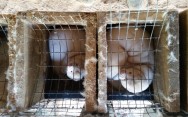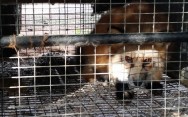Blog Archives
Home -
Posts tagged "Nazarita Goldhammer" (Page 2)
South Korea’s dogmeat trade has long been a national source of shame, especially to younger
people, who have developed more progressive views about animals. Pets such as domestic dogs and
cats have become more popular, changing people’s views of dogs as disposable animals that can
be farmed for meat. The dogmeat trade has been dying out on its own, but it has lingered on. The
dog meat trade is incredibly cruel and dogs are often killed in extremely painful ways. Dogs are kept
caged and suffer cruel conditions where they see other dogs killed. As social animals, this must be
unbearable to them.
Last year, South Korea’s parliament voted near unanimously to ban the dog meat industry. The law
takes effect in 2027 and will ban any future slaughter breeding and sale of dogs for dog meat.
The consumption of dog meat is based on historical traditions and unscientific beliefs about the
health benefits of dog meat. One of the most horrifying things about these traditions is that dogs are
deliberately tortured before death because of the belief that the adrenaline levels in the animal will
contribute to health benefits. Although dog meat was traditionally eaten in South Korea in the past,
there is evidence that this was not widespread and it became more popular due to false beliefs
about its effects on virility in older men. Animals have long been tortured because of human crazes
and the dog meat industry is a particularly cruel example. Not only are animals farmed for dog meat
but also abandoned pets are collected from the streets and slaughtered for the dog meat trade.
Activists inside and outside of the countries where dog meat is eaten have protested the practice.
On the other hand, condemning the practice has been associated with anti-Asian racism in incidents
in the US where restaurants have been falsely accused of selling dog meat. Consuming dog meat is
not “barbaric” because of a country’s culture, it is barbaric because humans are capable of extreme
cruelty towards animals when it is in their own interests.
Although it’s positive that dogs will be protected from this horrific cruelty in the future, the dog
meat ban should not draw attention away from the suffering of all animals such as cows, which in
Western culture are slaughtered for meat while in Korean culture traditionally were not killed and
kept as work animals. Animal rights activists and philosophers have argued against “speciesism,” in
which some animals are considered more deserving of safety than others. Banning dog meat is a
reflection of the public’s increasing intolerance of cruelty toward animals that are kept as pets.
Ultimately we must fight for animal rights to be extended beyond pets and towards all animals.
|
Tags: Animal Breeding,
Animal Cruelty,
animal rights,
Animal Suffering,
Cruelty to Dogs,
Dogmeat Industry,
Kevin Boileau,
Nazarita Goldhammer,
Speciesism,
Transhumanism,
Vegan
Animal welfare services are investigating the Ontario marine park where 14 whales and 1 dolphin have died in the space of a few years. The park is a big employer in the area and it has denied any wrongdoing, including any water quality issues that could have led to deaths at the park.
The park has a vested interest in keeping animals in roles where they are visible to the public, and formerly held shows in which its animals performed tricks and members of the public could feed its animals.
During a 2 year period, 12 beluga whales died. At the same time, provincial authorities had raised concerns about the park’s water quality and had recognized that all of the marine mammals were in distress. There have been protests and demonstrations for many years against the treatment of animals in the park. Citations against the park have resulted in 5 counts of animal cruelty by the Ontario Society for the Prevention of Cruelty to Animals in 2016 and 6 counts of cruelty by the OSPCA in 2017.
The animals that died include a beluga whale named Ikora, who died on October 24th 2019 and 10 others including a beluga named Bull, who died on November 23, 2021. 3 more deaths were confirmed in 2023, including Kisko, who was called “the world’s loneliest whale.” She was the last killer whale in captivity in Canada, and was originally captured along with Keiko, the star of Free Willy. She endured loneliness throughout her life in captivity, as she was confined to a small tank without companions. She died at the age of 47. The other animals who died in 2023 were a dolphin and a whale.
At one time Marineland had the most captive belugas in the world. Since Canada passed a law phasing out marine captivity, the park was forced to adjust. It is now shifting towards educational efforts. The animals are no longer available to the public and forced to perform tricks.
The lack of information surrounding the deaths of these animals obscures the conditions they may have been living in before they died. Captivity not only exposes animals to psychological risks of loneliness and confinement and the psychological pressure of being on display, animals could also suffer from neglect, poor environmental conditions and chronic health issues. Marine animal captivity should not be the norm unless it is explicitly for conservation purposes. The profit bottom line too often exposes animals to the risk of cruelty and neglect.
It’s no secret that the meat industry is trying hard to improve its image. As research continues to demonstrate the impact of meat and milk on greenhouse gas emissions, lobbyists for the livestock industry have been working to develop a counter-offensive.
The Protein Pact was launched in July 2021 and consists of mostly U.S. based livestock industry firms. The National Pork Producers Council is one of these groups, which challenged California’s Prop 12 before the Supreme Court and lost. The council’s president made headlines recently when he said he wouldn’t comply with even the modest animal welfare requirements of California law.
Chances are, you might have noticed a significant backlash against plant-based proteins and “fake meat” in the last year. There are strong indications that the meat industry has positioned influencers, dietitians and other messengers to influence public opinion on the benefits of meat. The Protein Pact organization works with Red Flag Consulting which is known for its efforts to interfere with climate policy action in the EU.
The group has also funded academic research to promote their claims. U.C. Davis’s CLEAR center, is funded in part by pact partner IFeeder and has been the subject of multiple investigative news stories, including one published in the New York Times, about its misleading communication efforts. Other controversial figures like Richard Berman are named in articles about the backlash against vegan meat. The Berman PR company has been involved in defending industries such as big tobacco.
“Big meat” has an image problem that can’t be whitewashed. It revolves around the cruel treatment of animals in industrial farms, as well as the harm the industry causes the planet. The industrial production of meat and exploitation of animals makes up 15% of global emissions and 60% of food production emissions. It’s no surprise that moves away from big meat and towards plant protein would be met with attempts to stifle these efforts.
It’s important to remember that influencers make their money from paid sponsorships and so-called candid advice may be funded by less than above-board sources. Articles with knee-jerk titles that claim to debunk veganism and vegan protein could well be part of a backlash that is more about business interests than science. Vegans can help to combat this disinformation by carefully fact-checking and tracing the sources of articles sent my family and friends.
|
Tags: Animal Cruelty,
Animal Protein,
animal rights,
Industrial Farming,
Kevin Boileau,
Meat Industry,
Nazarita Goldhammer,
Plant Protein,
Protein Pact,
Transhumanism,
Vegan,
Vegan Meat,
Wellness Influencers
Vegan Fashion week is now in its fifth year since 2019. This year’s event took place from October 8th through October 10th in LA. Vegan Fashion Week not only aims to highlight the creations of fashion designers who are showing that it is possible to design cruelty-free Vegan fashion, it’s also aimed at providing support for the transition towards more environmentally sustainable practices. For example, the Vegan Fashion Week nonprofit worked closely with designer Willa Phoenix to produce the first Pineapple leather shoes to walk the red carpet at the Oscars.
Vegan fashion is important because it challenges what’s possible for product development and materials used in manufacturing and production. Existing supply chains support cruelty-based materials like leather, which grow out of the animal exploitation industry and harm the environment. For example leather is produced through animal slaughter and it also creates extremely toxic byproducts through the process of tanning leather, which can affect water supply and human health.
The Vegan Fashion Week runway show featured clothes made from apple fiber, bamboo and linen. Celebrities like Tara Reid and Maggie Baird, Billie Eilish’s mother, attended the show. Vegan clothing is a fast growing industry, and the more you know, the more you can support brands that use cruelty-free materials. Showcasing innovation through events like vegan fashion week can help to normalize vegan fashion and spread awareness to the public.
For more information on Vegan brands and materials, please visit the links below:
https://www.projectcece.com/blog/594/best-vegan-clothing-brands/https://www.peta.org/living/personal-care-fashion/vegan-eco-clothing-belongs-in-your-closet/https://theecohub.com/vegan-fabrics/
Performing animals at the circus are held captive, forced to train and perform unnatural routines in front of crowds and to travel long distances in cramped conditions. Their lives are difficult, disorienting, uncomfortable and exposed. Wild animals often escape from the circus and there have been many cases of abuse and maltreatment.
Fortunately the days of performing animals at the circus are numbered. SoulUniverse circus has become the latest circus to drop performing animals from their routine, under pressure from animal rights activists, led by PETA. They join the list of circus companies who have moved beyond using animals like Lions, Bears, Tigers and Elephants. These include Ringling brothers and Barnum and Bailey circus,
Animal control officers had observed animals being mistreated or neglected at the UniverSoul circus. Big cats were locked in cramped cages all day, elephants and tigers were denied veterinary care and animals were often wounded and frequently attempted to escape.
“Exotic” animals are often forced to work to provide entertainment for humans. The circus is one of the contexts in which animals like big Cats, Elephants or Zebras are forced to work, but other examples include rides or at petting zoos. Larger animals are often made into a spectacle and kept in unnaturally cramped and restrictive conditions that are both physically and psychologically distressing. The concept of the circus should be one that revolves around fun, artistry and highly skilled human performers that choose to perform, not animals who don’t consent to be there.
If you’re visiting the circus with children, PETA has a list of animal-free circuses you can consult. (Please check to ensure all information is up to date). https://www.peta.org/wp-content/uploads/2021/06/animal-free-circuses-pdf.pdf
|
Tags: "Exotic" Animals,
Animal Freedom,
Animal Labor,
animal rights,
Bears,
Big Cats,
Circus Animals,
Elephants,
Kevin Boileau,
Lions,
Nazarita Goldhammer,
Tigers,
Working Animals,
Zebras
If you are a vegan you have sworn off eating animal products or wearing any animal products such as leather. You may not be aware of the prevalence of animal derived materials in many other everyday products. So much of our industrial world is built off the back of profiting from the slaughter of animals, it’s difficult to keep track. While it’s impossible to completely eliminate everything sourced from animal products, it is possible to make an audit of what you use and eliminate everything possible. If you are aware of our dependence on animal products you can also advocate for a new innovative economy in which we leave behind our dependence on the products of animal suffering.
The following are 5 animal products that may be found in common materials you don’t expect:
- Gelatine. Gelatine is known as the ingredient that is found in jelly and jelly sweets. However it’s also used as a binder in matchheads, sandpaper and pill capsules. It is made by boiling the skin and hooves of animals to create a gel substance.
- Casein. Casein is a byproduct of the dairy industry. It is a protein found in most mammals’ milk. It’s surprising how many common uses it has, such as in paint, glue, plastics and in dentistry and tooth repair.
- Lanolin. Lanolin is a substance in the skin of sheep and other woolly animals that acts as waterproofing for their wool. It is used in many lotions, balms and skincreams. It can also be found in shoe polish, in rust proofing and as an industrial lubricant.
- Guanine. Guanine comes from fish scales and is used to give a pearlized sheen to shampoos, nail polishes and other cosmetic and personal hygiene products.
- Ambergris. Ambergris is made from whale intestines and it is a fixative used in perfumes and a flavoring in foods and beverages.
Animal products are unfortunately an integral part of our production and industrial supply chain. This means that many common products are obtained in cruel and inhuman ways. Although vegans may be disciplined about cutting out foods that come from animals, it’s easy to forget how many other products are sourced from animals.
As well as avoiding products with animal ingredients, it’s important to advocate for alternatives and challenge the existing system. When it comes to clothing there are many alternative materials such as cactus leather and other materials that are vegan friendly. Industrial products can be more tricky but many products, like paint, have vegan alternatives. More companies are manufacturing 100 percent vegan products by using vegan solvents, binders and other materials. As a vegan it’s important to advocate for vegan industrial products and spread the word or find ways to encourage innovation in your industry. The following is a more exhaustive list of vegan products from Peta: https://www.peta.org/living/food/animal-ingredients-list/
The rise in Orca boat attacks has been a big story in the news. People have been alarmed by reports of Orcas off the Iberian peninsula biting off the rudder of boats. The incidents been on the rise since they began to be recorded in 2020 in the Gibralter Strait. Why are Orcas doing this? Some people are blaming an aggrieved matriarch called White Gladis who had a traumatic experience with a fishing boat. Researchers have theorized that White Gladis is passing this grievance to young orcas and teaching them how to attack boats. The narrative has some people cheering on orcas for fighting back against humans, and other people making dire predictions about the grievance spreading among Orcas, causing Orcas to sink boats. There are quite a few problems with this theory. First of all, Orcas have the power to sink boats, but they are not sinking them. Instead they are playing with rudders and damaging the boats. Another big problem with the idea of Orca armies is that the Orcas of the Gibraltar Strait are threatened. The latest reports are that there are only 35 individuals left.
The attacks do look intentional, but some theories suggest that this is actually a learning exercise for young Orcas. It’s a way to practice hunting without depleting fish stocks. If Orcas can learn how to hunt by tracking boats that have a fin, like dolphins or other prey, they can hone their skills without depleting their food supply. The trend has spread among young Orcas, and young Orcas are known for mimicking each other and adopting trends, just like human teenagers.
The truth is, no one actually knows why Orcas are interacting aggressively with boats. It has been pointed out that there have been periods of sustained oppression by humans of orcas, such as during the 1960s and 70s when humans stole Orcas from their families to keep in amusement parks. Yet, in all this time, Orcas haven’t struck against humans. As with so many human assumptions about the motivation of “the other”, whether it is another group of human beings, or a group of animals going about their lives, the story about a vengeful matriarch seems designed to stoke enmity and outrage. As usual the answer to these questions is likely more complex than the human tendency to simplify things and make them into black and white questions of good and bad. The truth is Orcas, just like us, have lives to lead, and their behavior usually indicates the pressures of their everyday lives. Those lives and motivations may be obscure to us, but we must refrain from projecting motivations onto Orcas when we don’t understand their world. This failing has caused untold destruction among humans, and it has allowed us to inflict violence on the animal “other” with impunity.
The real story of the Orca attacks on the Iberian peninsula may be unclear, but one thing should be obvious. Like many other species, Orcas have had to fight to maintain their livelihoods under threat of human encroachment. If Orcas are approaching boats in a habitat crowded by humans, it shouldn’t be a surprise.
https://www.washingtonpost.com/opinions/2023/06/19/orca-attacks-sinking-boats-science/
|
Tags: Animal Culture,
animal rights,
Animal Sentience,
Cetaceans,
Endangered Animals,
Kevin Boileau,
Marine Life,
Nazarita Goldhammer,
Orca,
Orca Boat Attacks,
Transhumanism
Children roaming through the woods with air rifles may sound like dystopian science fiction, but it almost became a reality in New Zealand. Local children were encouraged to compete to shoot feral cats as part of an effort to reduce the population of animals that threaten the ecosystem, and raise money for the local area. Children were encouraged to shoot as many cats as possible for a cash prize of $155.
During the previous year’s event, more than 250 children killed 427 animals, mostly possums, hares and rabbits. Although the cat hunting competition was called off this year, the events in other categories will still go ahead.
The event was canceled partly due to public outrage over the massacre, but also due to dangers to children themselves, and the potential danger to domestic cats. In addition to the cruel murder of feral cats, opponents of the competition pointed out what should be obvious, which is that there is no way to tell for sure whether a target is a feral cat or someone’s beloved pet.
Feral cats are considered an invasive species that threaten native wildlife in New Zealand. Animal rights advocates have stressed that solutions like the cat hunting competition are not a sustainable or effective way of dealing with this issue. Critics argued that it was more about glorifying violence and teaching children to view animals as disposable objects rather than finding a long-term solution to the problem.
One such alternative solution is Trap-Neuter-Return (TNR), a method that has been successfully implemented in many parts of the world. TNR involves trapping feral cats, sterilizing them, and returning them to their colony. This helps to control the population of feral cats without resorting to lethal methods. It also reduces the risk of disease transmission and other negative impacts of uncontrolled feral cat populations. Another alternative is to educate the public on responsible pet ownership and the importance of spaying and neutering cats. This can help to prevent feral cat populations from growing and reduce the number of cats that end up on the streets.
Shooting cats in an inhumane manner with air rifles, may also have caused them to die a more painful death. The obvious violence and suffering felt by animals was intertwined with the grave risk to children both psychologically and physically. Children were not only exposed to dangerous and violent behavior, they were also at risk of injuring themselves or others.
The competition represents a bloodthirsty and unnecessary culture of ‘Man vs Nature’ where children are encouraged from a young age to see themselves as violently dominating the environment and the creatures within it. The controversy may have prevented children from hunting cats, but it has not shut down the competition entirely. Children will hunt animals in a wanton way that will cause great psychological harm to the children and cruelty and suffering to animals.
Humans learn to designate animals like cats or other companion animals higher on a food chain, with humans at the top. We teach our children that humans are separate from animals and nature, and that only some of us have a right to live in freedom from suffering and slavery. Animal rights advocates should celebrate that this cruel event has been canceled, but be careful not to ignore that non-domestic animals remain the victims of cruel hunting and culling, and that children are being taught lessons of cruelty, not compassion.
|
Tags: Animal Cruelty,
Children and Animals,
Education,
Feral Cats,
Hunting,
Kevin Boileau,
Nazarita Goldhammer,
Non-violence,
Psychological Damage,
Transhumanism,
Trap Neuter and Release
Many countries and states have been waking up to the need to enshrine the rights of animals and the environments in law. European countries in particular have been setting a trend in passing laws that recognize animal rights and introduce punishments for animal cruelty. What countries are passing these laws and what are the limitations?
Spain
Spain has recently passed laws that increase punishments for animal mistreatment. Amongst other changes, it has also made training classes for dog owners mandatory and made it illegal to leave them for more than 24 hours. In 2020 Spain also passed laws that allowed for joint custody of animals in divorce, recognizing that companion animals were “sensitive, sentient beings” rather than property.
Switzerland
Switzerland is known for having animal rights laws that are stricter than other countries. The right to animal dignity is constitutionally protected. In 2022, Swiss people failed to vote for a law that would have banned industrial farming.
Portugal
In Portugal there is a law that criminalizes abuse and neglect of pets but it has faced challenges because animal protection is not enshrined in the Portuguese constitution.
Netherlands
The Netherlands may soon ban harmful breeding of pets.
What are the Weaknesses of Animal Rights Laws?
One weakness in animal rights laws is who we choose to protect. This means that some animals are considered more worthy of protection than others, for example there are more laws to protect companion animals than lab animals. In the case of Spain’s new animal protection law, people have protested that the animal cruelty laws don’t protect hunting dogs and farm animals. The laws also don’t affect bullfighting, one of the cruelest “sports” involving animals.
The manner in which animal protection laws are introduced often says a lot more about what is acceptable or normal for humans than it does about what animals need or deserve. It’s a positive thing that animal sentience is being recognized in divorce and pet custody. On the other hand, it’s easy for people to understand companion animals as an accessory to human existence. Meanwhile other animals like lab animals, farm animals and invertebrates are frequently under-protected in the law. Many other animals that don’t meet the definition of who humans consider to be intelligent or worth protecting aren’t legally protected. As laws to protect animal welfare proliferate, we need to locate the decision-making process within a new transhumanist framework in which our human perspective is de-centered and animals and ecosystems perspectives are at the center.
The question of whether it should be legal for people to rescue animals from slaughter houses and industrial farms is the subject of a recent New York Times op-ed.
It’s a question that deserves serious consideration. Animal activists have forced the public to confront these questions by filming conditions in slaughterhouses and industrial farms. Their reporting has revealed conditions of unimaginable horror and cruelty, and it has confronted us with our obligation not to be bystanders.
If you are aware of animal abuses committed at large agricultural facilities or slaughterhouses it’s not that simple to do something, however. If concerned citizens want to step in and rescue animals they can face serious charges. The NYT op-ed focuses on the actions of activists at DxE (Direct Action Everywhere) who have gained access to slaughterhouses and revealed abominable treatment of animals. In this case, the activists witnessed chickens at Foster Farms facility who were killed in violent haste. The activists’ infrared cameras showed live birds thrown, crushed and suffocated under piles of dead birds. Many weren’t stunned properly before being killed. There were other reports from U.S. Department of Agriculture inspectors of birds that had been dunked alive in a boiling water tank for defeathering. The activists rescued several animals from the plant, and there are other cases where activists have stepped in and rescued animals from industrial farming facilities and slaughterhouses.
The NYT op-ed made the point that if you saw someone boiling animals alive in your neighborhood, you would feel an obligation to step in and rescue the animals. Why is it any different at a Big Ag facility? There are laws that allow people to rescue dogs from hot cars, yet rescuing animals from cruel industrial farms is charged as theft, and filming the scenes of cruelty can be charged as criminal trespass.
Many of the activists say they are happy to stand trial to help set new precedents for animal rescue. This can pay off, such as in the case of a Utah jury who acquitted two activists of burglary and theft for taking two sick piglets from a Smithfield Farms facility.
This is just the beginning of a process that is stacked against Good Samaritans who want to rescue animals who are being treated cruelly. The bigger problem is that the industrial farming and meat industry will continue to commit cruelty as a matter of course. Industrial farming and the meat industry have sacrificed animal lives to the production line. Rescuing animals from these conditions is the first step towards making society confront what the appetite for industrially farmed meat means for animal lives.
|
Tags: Ag Gag,
Animal Abuse,
Animal Cruelty,
Animal Rescue,
animal rights,
Animal Rights Activists,
Chickens,
Factory Farming,
Kevin Boileau,
Nazarita Goldhammer,
Transhumanism








Social Media